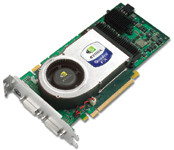
NVidia s line of PCI Express solutions range from the entry-level Quadro FX 540 up to the high-end Quadro FX 4400, featuring up to 512MB of RAM.
|
WHO'S ON BOARD THE PCI EXPRESS?
There are really only three primary players in the professional workstation graphics marketplace. It is a marketplace that is increasingly focused on supporting the acceleration of workstation applications using the OpenGL and Microsoft DirectX standards. Nvidia currently owns the lion's share of the overall market, followed by ATI Technologies and then 3DLabs. Matrox could be considered as a very minor fourth player, though admittedly this privately owned Canadian company seems focused on different markets than the other three, and I include it here mainly because they do offer some unique DCC-related products that fill a niche in the editing and multi-monitor environment.
NVIDIA
Nvidia (www.nvidia. com/). has taken the industry by storm over the past four or five years. Their very successful Nvidia Quadro FX family has become a defacto standard in many professional workstations. They have introduced entire families of boards to fit nearly every performance and price point. Added to Nvidia's comprehensive family of products is their successful and stable Unified Driver Architecture (UDA) that allows all of their products to be driven from a single software application with sophisticated programmability. For the information technology manager responsible for large operations and many systems to attend to, Nvidia's unified driver approach is exactly the right tool.
But of course Nvidia's unified driver approach wouldn't be as appealing if they didn't have some extraordinary graphics accelerators to drive. The high-end Nvidia Quadro FX solutions took AGP 8X graphics to new levels of performance. While Jeff Brown, Nvidia's GM of professional graphics product management, wouldn't absolutely say there would be no more new AGP offerings from the company, he made it pretty clear that PCI Express is where the future is. "During this period of transition to PCI Express, we expect our AGP products to continue to be strong sellers, Brown comments. But everyone knows where the industry is headed."
Nvidia's solutions for PCI Express range from the entry level Quadro FX 540 up to the ultra-high-end Quadro FX 4400, which features up to 512MB of RAM. Nvidia has also introduced the PCI Express version of their Genlock and Framelock solution, the Quadro FX 4400G and has plans for other specialized solutions, including an SDI solution for 10-bit HD video output.
ATI
ATI has been in the graphics market for 20 years and lately, of course, their biggest competitor is Nvidia. Their aggressive introduction of a new range of PCI Express graphics accelerators demonstrates how serious they take this competition. "We are quite clear on our mission," says Dinesh Sharma, director of workstation products for ATI Technologies (www.atitech.com/). "We're extremely focused on giving customers the highest quality product to meet the needs of the professional workstation market at multiple price/performance points."
Competition in the market is good for end users, and ATI has been going head to head against Nvidia for many years. A few years back, the primary weaknesses of ATI's workstation products matched up exactly with one of the primary strengths of Nvidia's products - the all important software drivers and the associated programmability of graphics accelerators. It was a perfect storm that made for some choppy seas at ATI.
"I was hired specifically to fix our software issues," Sharma admits. "That was my first priority when I came on board with ATI." He quickly adds, "We've successfully addressed all these issues and have moved forward with a very powerful and comprehensive software solution."
ATI also now offers a unified driver architecture that functions across their entire line-up of products. This is an important accomplishment for ATI and has, in my opinion, raised the bar a big notch for their products. Their PCI Express FireGL Visualization series includes the FireGL V3100, V3200, V5100 and V7100. ATI also makes the point that they don't use any "bridge" solutions to implement the PCI Express standard as they claim other manufacturers are doing with some associated performance hits. If performance is your ultimate deciding factor, visit www.spec.org/ to get the latest performance data.
3D LABS
3Dlabs (www.3dlabs.com/) casts no illusions about exactly where they fit into the graphics marketplace. "We cater to the ultra high end," says Jeff Little, director of product marketing. 3Dlabs has enjoyed success with its AGP-based Wildcat lines and has recently introduced the ultra-high-end PCI Express-based Wildcat Realizm 800 product with 640MB of RAM and the multi-view option, which allows for framelocking, genlocking, synchronized framebuffer swap and synchronized refresh rate. With the Realizm 800 product, 3Dlabs appears well positioned to maintain a strong hold on the ultra high end of the PCI Express market.
MATROX
The first workstation-based editing system I worked on had a Matrox dual-monitor graphics card. Matrox still sees this as their market niche. "Though we have respectable OpenGL and Direct X performance, our priority isn't to top any benchmark charts in those areas," says Caroline Injoyan product manager for video workstation products. The company sees editing and pro multi-monitor applications as their market. Injoyan is proud to add, "We target the professional who demands the best performance and quality in multi-monitor applications."
One of the products that Matrox is especially proud of is their AGP-based triple-monitor-capable Parhelia. It's currently the only triple monitor graphics card on the market. With the Parhelia, digital artists can have their standard dual-monitor set up, with an additional third computer monitor or the third monitor can have WYSIWYG video output to a television. Currently Matrox has not introduced any PCI Express products, but they have told Post that customers should expect an announcement from them next month.